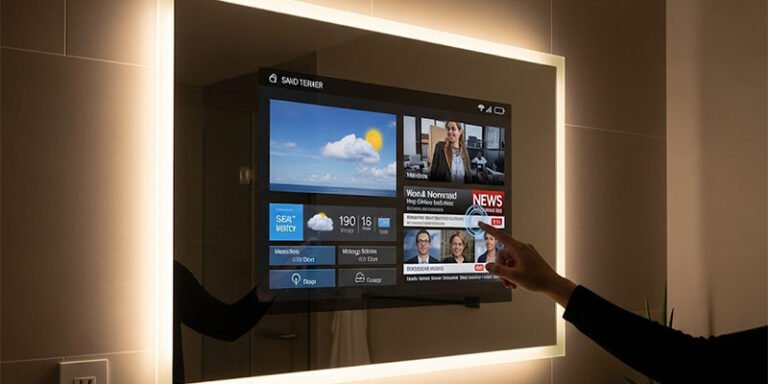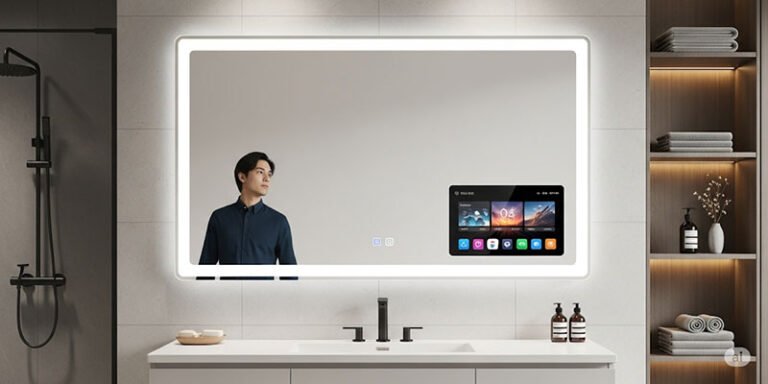A smart mirror looks like a regular mirror but has hidden technology that lets it do much more than just show your reflection. It combines a traditional mirror with a digital screen behind the glass, so users can see information like the time, weather, and news right on the mirror’s surface. This smart device often connects to your phone or home Wi-Fi, allowing for hands-free updates and even control over other smart home features.
Many smart mirrors include touch screens, voice assistants, or fitness tracking tools, making them useful in bathrooms, bedrooms, or home gyms. With customization options and a range of designs, smart mirrors can fit different styles and needs, from simple daily reminders to full interactive displays.
Key Takeaways
- A smart mirror blends a standard mirror with an interactive digital display.
- It offers features like info updates, connectivity, and smart controls.
- Designs and functions vary, making it useful in many spaces.
What Is a Smart Mirror?
A smart mirror combines a traditional reflective surface with digital features to display information and interactive content. It often uses modern components to show helpful details like time, weather, and notifications right on the mirror.
Definition and Core Components
A smart mirror is a device that looks like a normal mirror but also acts as an interactive display. It uses a two-way mirror, which lets a screen shine through from behind without blocking your reflection. This makes it possible to see both your own image and digital data at the same time.
The main parts of most smart mirrors are:
- Two-way mirror glass
- Digital display (like an LCD or LED screen)
- Sensors (for touch, motion, or light)
- A small computer, often a Raspberry Pi, to run software and manage data
Some smart mirrors also include speakers, microphones, and Wi-Fi or Bluetooth for connecting to apps and the internet.
How Smart Mirrors Work
The working process starts with the two-way mirror, which allows light from both sides. Behind the glass, a digital display presents things like calendars, news, or the weather. The display is only visible when it is turned on and blends in with the mirror when off.
A Raspberry Pi or similar compact computer controls what appears on the screen. This small computer processes information from the web or sensors and updates the display. Sensors let the smart mirror adjust brightness, respond to motion, or enable touch controls.
Many smart mirrors connect to smartphones or home networks. This connection lets users manage settings, sync data, or even take voice commands, depending on the model.
Comparing Smart Mirrors and Traditional Mirrors
Smart mirrors and regular mirrors differ in what they offer the user. A traditional mirror only shows a reflection. It has no extra features and cannot display information or connect to other devices.
In contrast, a smart mirror provides real-time data and can be interactive. Users can see not just their reflection, but also news headlines, clock, weather updates, and even fitness stats. Some models add features like Bluetooth audio, app controls, or smart home integration.
| Feature | Traditional Mirror | Smart Mirror |
|---|---|---|
| Reflection | Yes | Yes |
| Digital Display | No | Yes |
| Sensors | No | Often included |
| Connectivity | No | Wi-Fi/Bluetooth possible |
| Custom Information | No | Yes |
This difference makes smart mirrors better for people who want both a mirror and access to important information in one device.
Key Features and Technology
Smart mirrors blend traditional mirrors with technology. They provide interactive features like real-time information, voice and touch controls, and various connectivity options.
Digital Display Capabilities
A smart mirror places a digital display behind a two-way mirror, letting users see essential information superimposed over their reflection. This screen can show the time, date, weather, news headlines, calendar reminders, and more without needing a separate device.
Real-time information updates are possible because many smart mirrors connect to Wi-Fi, making data accurate and timely. Some models use Bluetooth to display notifications, music controls, or incoming calls from a synced phone.
Many mirrors let users customize their display. They can choose which apps, widgets, or features are most important for daily routines. The digital display stays hidden when not in use, keeping the mirror’s look clean and modern.
Motion Sensors and Interactivity
Motion sensors add a layer of convenience to smart mirrors. When someone approaches, the mirror can automatically activate the display or begin custom routines based on pre-set preferences.
These sensors make the mirror more interactive and energy-efficient. The screen dims or turns off when no one is nearby, which saves power. Some smart mirrors even track user presence, adjusting features like lighting or showing personal information only when the primary user is detected.
In homes, motion sensors can help with hygiene too—avoiding the need to touch the surface. In public settings, they add a hands-free way to interact, making them more sanitary and efficient.
Voice Control and Voice Commands
Voice control is a common feature in today’s smart mirrors. Many models come with built-in voice assistants, such as Amazon Alexa, Google Assistant, or proprietary systems.
With voice commands, users can ask for weather reports, play music, check on news, or control other smart devices in the home. Common commands include:
- “What’s the weather today?”
- “Show my calendar.”
- “Turn on the bathroom lights.”
This hands-free control is especially helpful when users have wet or soapy hands, like in bathrooms or kitchens. Voice recognition can be personalized for different users, and many mirrors update their software to offer new functions regularly.
Touchscreen and User Interface
A touchscreen transforms the mirror into an interactive panel. Users can tap, swipe, and scroll to navigate menus, launch apps, or adjust settings right on the glass.
The touchscreen interface is often designed to be simple and clear. Icons, buttons, and widgets are large and easy to use, even with damp or gloved hands. Some interfaces allow for split screens, displaying multiple widgets—like weather and calendar—at once.
Smart mirrors with this feature sometimes support gestures or handwriting, letting users draw reminders or adjust smart home controls with quick touches. The combination of touchscreen control and visual feedback gives users a flexible, personalized experience.
Smart Mirror Functionality and Applications
Smart mirrors offer features that go beyond simple reflection. They connect with other devices, provide useful daily updates, and help users track their health and fitness.
Smart Home Integration
Smart mirrors can become a central part of the smart home ecosystem. They often connect through WiFi or Bluetooth and work with voice assistants like Alexa or Google Assistant. Some models allow users to control lighting, thermostats, and security systems directly from the mirror.
They may sync with smart home devices such as connected lights, speakers, or door locks. This connectivity allows users to adjust room settings or play music while getting ready in the morning. The mirror’s interactive display can also show alerts about household activity, such as someone ringing the doorbell or motion detected outside.
Integration with other smart home platforms ensures that updates, reminders, or notifications appear on the mirror screen. This makes it easier for families or individuals to manage daily routines and stay connected with their home environment.
| Smart Home Features | Available on Smart Mirrors |
|---|---|
| Voice assistant integration | ✔️ |
| Lighting/thermostat controls | ✔️ |
| Security alerts | ✔️ |
Daily Information and Notifications
Smart mirrors display useful information that helps users start the day. The digital display can show the weather forecast, calendar events, traffic updates, and news headlines. Recent designs let users customize widgets or screens to focus on what matters most to them.
Many smart mirrors also support touch controls. This makes it simple for users to check notifications or switch between different types of information, turning the mirror into an interactive experience instead of just a display.
Some smart mirrors can connect to mobile apps, allowing push notifications for texts, emails, or reminders. Real-time updates keep users informed about appointments or changes to their schedule, often right as they get ready in the morning.
Key information often displayed:
- Time and date
- Weather conditions and forecast
- Calendar reminders
- News/headlines
- Traffic updates
Fitness and Health Monitoring
A fitness mirror is a type of smart mirror designed for exercise and health tracking. Some models provide guided workout routines, yoga classes, or live personal training sessions displayed on the mirror.
The mirror’s sensors or integrated cameras can monitor heart rate, posture, or workout performance. It may also sync with wearables or fitness trackers to collect and display user health data, such as step counts or calories burned.
Users can:
- Track progress over time
- Get live feedback during workouts
- Set fitness goals and monitor achievement
This interactive experience brings a personal trainer-like feature into the home and can encourage a consistent healthy routine. Smart mirrors used for fitness blend the functions of a display, coach, and health monitor in one device.
Types and Use Cases of Smart Mirrors
Smart mirrors are used in different settings, from homes to stores, each with unique features. They combine traditional reflection with smart technology to add helpful tools, display information, and support daily routines.
Bathroom Mirrors and Vanity Use
Smart mirrors for home and vanity use are often found in bathrooms. These mirrors typically have built-in lights, anti-fog features, and can show the time, weather, or calendar.
Some models allow users to play music, check traffic updates, or get reminders while getting ready in the morning. Touch screens are common, making it easy to adjust settings for things like brightness or temperature.
These mirrors focus on convenience and helping users multitask. By placing the right information in the right spot, they make daily routines smoother and more efficient.
Smart Bathroom Mirrors
A smart bathroom mirror can do much more than just reflect a face. Many have features like voice assistants, Bluetooth speakers, and even video calling.
Health and skincare features add another layer of usefulness. Some mirrors can analyze skin problems, track changes over time, and suggest products. Temperature and humidity sensors help users keep track of bathroom conditions, which is important for skin and hair care.
Some advanced models include programmable lighting to simulate daylight or evening and demisters for a clear view after a shower. This smart technology blends personal care with daily planning.
Retail and Augmented Reality Applications
Retailers use smart mirrors to support shopping and improve the customer experience. Stores often install these devices in dressing rooms or main shopping spaces.
Augmented reality features allow users to see how clothes, glasses, or makeup will look without having to try them on physically. Some mirrors provide skincare analysis, product suggestions, and personalized tips. Customers can even save fitting choices or instantly order items through the mirror’s interface.
This type of smart mirror helps stores offer a more interactive and efficient way to shop. For example:
- Virtual try-ons for clothes or accessories
- Personalized beauty advice
- Quick product information
By combining digital services with real-time reflection, these mirrors boost both engagement and sales.
Customization, DIY, and Popular Brands
People can choose to build a smart mirror from scratch or buy one from popular brands. Each option provides different choices for customization, features, and price.
DIY Smart Mirror Projects
DIY smart mirror projects have become popular because they let people control every part of the design. A basic DIY smart mirror typically uses a Raspberry Pi or similar small computer, a two-way mirror, and a monitor as the display. Builders follow step-by-step guides, which help even beginners assemble the hardware and load simple software.
Creating a smart mirror at home is often less expensive than buying a ready-made one. With some patience, users can add extra features such as motion sensors, voice assistants, or different display modules for news, time, and weather. The open-source community provides helpful resources, templates, and plugins to make setup easier.
Some DIY smart mirrors use touchscreens or gesture controls. Others focus on simple displays. The key advantage is the ability to choose the exact features that fit the user’s needs and preferences.
Customization Options
Smart mirrors can be customized in look and function. DIY builders and commercial brands offer ways to change the display layout, background colors, widgets, and types of information shown. Typical display options include weather, news, calendars, and reminders.
Users can select the size, shape, and style of the mirror frame. Lighting is another area for personalization—some add LED strips around the edges for better clarity or mood effects. Touch and voice controls add convenience, while integrations allow for smart home control.
For advanced users, adding artificial intelligence features or fitness tracking is possible. Some brands allow app selection through their own platforms, while DIY builders can add almost any open-source module they like. Customization lets each smart mirror match the space and lifestyle where it’s used.
Leading Brands and Models
A few companies are well-known for making pre-built smart mirrors. HiMirror is one of the most recognized brands, focusing on beauty and skincare analysis using built-in cameras and sensors. Their mirrors display skin health data and personalized tips along with standard smart features.
Other names include Simplehuman, which offers mirrors with sensor lights and voice commands, and Capstone Connected, which features touchscreen displays and multiple app integrations. Some brands focus on fitness, such as Mirror by Lululemon, which combines a full-length mirror with interactive workout sessions.
Buyers can compare each model’s display quality, extra features, and compatibility with other smart devices. Leading brands usually provide regular software updates and customer support, which is a benefit over most DIY solutions.
Smart Mirror Costs and Considerations
Smart mirrors come with unique features that affect their price, setup, and future updates. Buyers should look at upfront costs, installation needs, and how new technology may change their choices in the years ahead.
Smart Mirror Cost Factors
Smart mirrors cost more than regular mirrors because of the extra technology inside. Prices range widely. Small personal smart mirrors may start around $100–$500. Larger full-length models that include more advanced features can cost between $500 and $2,000 or more.
Key features that affect cost include:
- Built-in LED lighting
- Touchscreen displays
- Voice assistants and sensors
- Camera and speakers
- TV or streaming capabilities
DIY smart mirror builds are an option for tech-savvy buyers, and these can sometimes be created for under $100 for basic models. However, professional models will cost more due to quality finishes, better displays, and more complex features.
Advanced options, like models with cameras, microphones, or TV integration, also require a higher budget. The brand trusted, technology used, and size all play a major role in the final price.
Installation and Maintenance
Installation of smart mirrors may need professional help, especially with wall-mounted or larger mirrors. Built-in electronics and wiring for LED lighting can require access to electrical outlets or even new wiring in some homes.
Some mirrors are plug-and-play and can be set up by the user, while others may require a technician. This adds to the cost and needs to be considered before buying.
Maintenance includes keeping the glass clean and sometimes updating software. If the smart mirror has internet access, regular updates are needed to keep features and apps secure and running smoothly. Replacement parts, like LEDs, may also be needed over time.
Homeowners should also think about warranty coverage and technical support, as repairs can be more complicated than with a regular mirror.
Future Trends and Innovations
Smart mirrors continue to improve as new technology is developed and costs come down. Integration with home automation systems is becoming more common. This allows users to control lights, check calendars, and get news directly on the mirror.
LED lighting is getting brighter and more energy efficient. Newer smart mirrors may feature better voice control, more accurate sensors, or health tracking functions for things like weight and skin condition.
The trend is moving toward more affordable models with a wider range of features. Future smart mirrors may include improved privacy controls, better connectivity, and easier installation for homeowners and renters.




